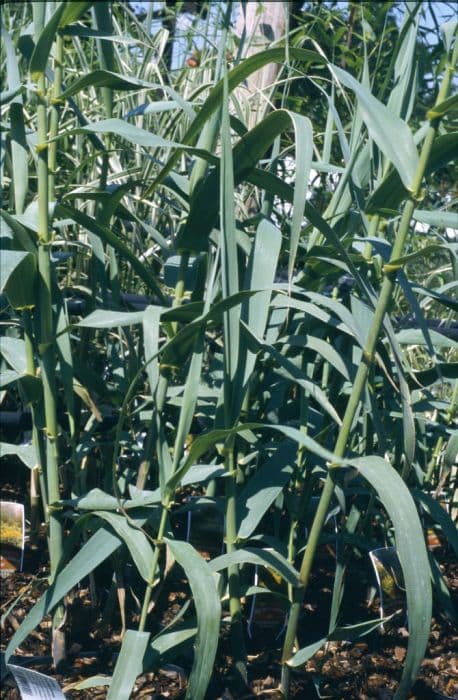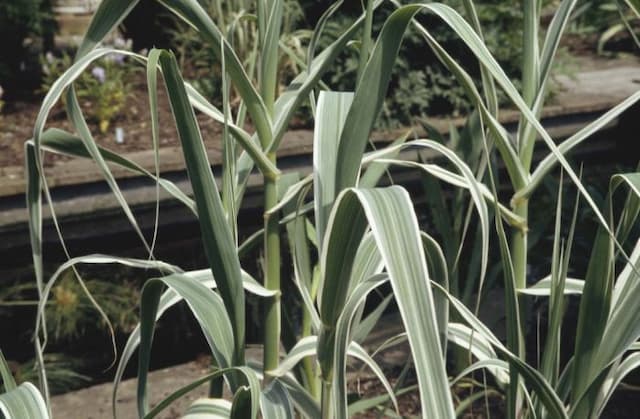Pheasant's Tail Grass Anemanthele lessoniana

ABOUT
Anemanthele lessoniana, commonly known as the gossamer grass or pheasant's tail grass, is characterized by its visually striking and elegant appearance. This perennial grass is known for its fine, arching foliage which has a distinctive color palette that changes with the seasons. The leaves of gossamer grass are narrow and exhibit a green hue with hints of yellow and orange, providing a warm tonal blend which deepens to reveal more intense oranges and reds during the cooler months. This contributes to a fiery display that can add drama to a garden setting. The grass has a clump-forming habit, with the leaves forming a fountain-like shape that gently flows and moves in the breeze, creating a sense of softness and dynamism. In summer, the plant bears airy panicles of tiny, wind-pollinated flowers that rise above the foliage. These flowers can add a subtle texture and movement to the garden as they catch the light and sway delicately. As the season progresses, the flowers may turn into fine seed heads that extend the visual interest of gossamer grass even after the blooming period is over. Overall, the gossamer grass is highly appreciated for its feathery texture, the changing colors of its foliage throughout the year, and its overall contribution to the aesthetics of a landscape without being dominant or overpowering. Its soft, mound-shaped profile and the responsiveness to the wind make it a particularly enchanting choice for gardens that emphasize naturalistic or prairie-style plantings.
About this plant
 Names
NamesFamily
Poaceae
Synonyms
Pheasant's Tail Grass, New Zealand Wind Grass, Gossamer Grass, Wind Grass
Common names
Stipa arundinacea, Oryzopsis lessoniana, Anemanthele lessoniana.
 Toxicity
ToxicityTo humans
Gossamer grass, the most common name for Anemanthele lessoniana, is not widely reported to be toxic to humans. There are no well-documented cases of poisoning or specific symptoms associated with ingesting this plant. It is generally considered safe to come into contact with for gardening and landscaping purposes, but as with many plants, it is not recommended for consumption.
To pets
Gossamer grass is not commonly known to be toxic to pets either. This plant is not listed among the toxic or harmful plants for animals such as cats and dogs. Therefore, there are no specific symptoms of poisoning associated with it. However, it is always advisable to discourage pets from eating ornamental plants as they might cause digestive upset or an allergic reaction irrespective of their toxicity profile.
 Characteristics
CharacteristicsLife cycle
Perennials
Foliage type
Evergreen
Color of leaves
Green
Height
3 feet (0.91 meters)
Spread
3 feet (0.91 meters)
Plant type
Grass
Hardiness zones
9
Native area
New Zealand
Benefits
 General Benefits
General Benefits- Ornamental Appeal: Pheasant's Tail Grass, as it is commonly known, adds aesthetic value to gardens with its graceful, arching foliage and feathery flower heads.
- Low Maintenance: It requires minimal care once established, making it ideal for gardeners seeking attractive yet easy-to-maintain plants.
- Drought Tolerance: The grass is drought-resistant, conserving water and surviving in dry conditions where other plants might struggle.
- Wind Resistance: Its flexible stems and leaves can withstand windy conditions, making it suitable for exposed or coastal gardens.
- Wildlife Support: The seed heads provide food for birds during autumn and winter, while its structure offers shelter.
- Erosion Control: The dense growth of Pheasant's Tail Grass helps stabilize soil and prevent erosion on slopes or in areas prone to soil loss.
- Seasonal Interest: This grass changes color with the seasons, from green in spring and summer to shades of gold, orange, and red in autumn, providing year-round visual interest.
- Textural Contrast: It adds a fine texture that contrasts well with broader-leaved plants, contributing to a diverse and balanced garden design.
 Medical Properties
Medical PropertiesThis plant is not used for medical purposes.
 Air-purifying Qualities
Air-purifying QualitiesThis plant is not specifically known for air purifying qualities.
 Other Uses
Other Uses- Anemanthele lessoniana, commonly known as pheasant's tail grass, can be used as a natural dye for fabrics, imparting a subtle color sourced from the plant's foliage.
- Pheasant's tail grass may serve as a deterrent in the garden for certain pests due to its dense growth habit, which can be uninviting for pest habitation.
- The dried leaves of pheasant's tail grass can be used in basketry and weaving, offering an organic and rustic material for handmade crafts.
- The plant can be utilized for soil stabilization and erosion control on slopes owing to its robust root system that anchors soil.
- The flower inflorescences of pheasant's tail grass are sometimes incorporated into floral arrangements, adding a touch of wild grace to bouquets.
- It can be planted as a privacy screen in the garden since it can grow to form dense clumps that obscure the view through them.
- Pheasant's tail grass is often used as a backdrop in photography to create a naturally diffused and textured background.
- Due to its attractive and flowing form, the grass is sometimes used in landscape painting and drawing as a subject for portraying natural movement.
- In colder regions, pheasant's tail grass can provide winter interest in the garden as it retains its shape and color when many other plants have died back.
- It can be used as a companion plant to complement more flamboyant garden species, with its fine texture providing a contrast to more bold-leafed plants.
Interesting Facts
 Feng Shui
Feng ShuiThe plant Anemanthele lessoniana, commonly known as Pheasant's Tail Grass, is not used in Feng Shui practice.
 Zodiac Sign Compitability
Zodiac Sign CompitabilityPheasant's Tail Grass is not used in astrology practice.
 Plant Symbolism
Plant Symbolism- Flexibility: Anemanthele lessoniana, commonly known as Pheasant's Tail Grass, has slender, arching foliage which moves gracefully in the wind, symbolizing flexibility and the ability to adapt to changing circumstances.
- Resilience: This plant is known for its toughness and ability to thrive in a variety of soil types and weather conditions, representing resilience and endurance.
- Change: The leaves of Pheasant's Tail Grass change color throughout the seasons, from green to golden to orange tones, symbolizing change and the passage of time.
- Beauty: With its fine-textured foliage and feathery flowers, Pheasant's Tail Grass is often associated with aesthetic beauty and natural elegance.
 Water
WaterPheasant's tail grass prefers evenly moist soil, so regular watering is important, especially during hot and dry periods. Generally, watering this plant once a week with about 1 to 1.5 gallons of water should suffice, ensuring the soil is hydrated but not waterlogged. During extreme heat, you may increase watering frequency to twice a week, monitoring the soil moisture levels to prevent over-watering. Always water at the base of the plant to avoid wetting the foliage, which can lead to fungal diseases. In the cooler months, reduce the amount of water as the plant requires less moisture.
 Light
LightPheasant's tail grass thrives in full sun to light shade. Ideally, the plant should receive at least 6 hours of direct sunlight daily. The best spot for this grass is an open area where it is exposed to the sun's rays for most of the day, which promotes the healthiest growth and best coloration of the foliage.
 Temperature
TemperaturePheasant's tail grass tolerates a wide range of temperatures, but it grows best in temperatures between 60 and 75 degrees Fahrenheit. It can survive minimum temperatures down to about 20 degrees Fahrenheit but may suffer die-back when temperatures drop below freezing. Pheasant's tail grass will remain evergreen in milder climates but may go dormant in areas with harsh winters.
 Pruning
PruningPheasant's tail grass should be pruned to remove dead foliage and to maintain its attractive shape. This is best done in late winter before new growth begins. Pruning once a year is sufficient, cutting back the dead foliage to about 4-6 inches above ground level. This keeps the grass tidy and allows new shoots to emerge for the upcoming season.
 Cleaning
CleaningAs needed
 Soil
SoilPheasant's tail grass thrives in a well-draining soil mix with organic matter such as peat or compost. A suitable mix would be two parts garden soil, one part peat or compost, and one part perlite or sand. It prefers a soil pH between 5.5 and 7.5.
 Repotting
RepottingPheasant’s tail grass is not often repotted as it is a fairly hardy plant. It should be repotted only if it outgrows its container, usually every 2 to 3 years. Use a larger pot to give the roots more room to grow.
 Humidity & Misting
Humidity & MistingPheasant's tail grass prefers moderate humidity levels but is quite adaptable and tolerates a range of conditions. No specific humidity requirements are necessary for this hardy plant.
 Suitable locations
Suitable locationsIndoor
Place in bright, indirect light.
Outdoor
Full sun to part shade; protect from strong winds.
Hardiness zone
8-10 USDA
 Life cycle
Life cycleAnemanthele lessoniana, commonly known as pheasant's tail grass, begins its life cycle as a seed, which when conditions are right, germinates and sprouts into a small seedling. The plant then enters into a vegetative stage, where it develops a tufted clump of narrow, green, and bronze leaves, gradually maturing and increasing in size. In the flowering stage, typically in summer, it produces airy panicles of tiny, wind-pollinated flowers which can range from green to a purplish hue. After pollination, these flowers develop into seeds by late summer or early autumn. The plant may die back in colder climates during the winter but can persist as an evergreen in milder regions. Throughout its life cycle, pheasant's tail grass may also spread through rhizomes, creating larger colonies over time.
 Propogation
PropogationPropogation time
Spring-early summer
The most popular method of propagation for Pheasant's Tail Grass (Anemanthele lessoniana) is sowing seeds. The optimal time to sow seeds is usually in the spring after the danger of frost has passed. To propagate from seed, one should scatter the seeds thinly onto a well-drained, fertile soil surface and lightly cover them with a sprinkling of soil. Keep the soil moist but not waterlogged, and place the pot or tray in a warm location with indirect light. Germination typically occurs within 2 to 4 weeks. Once the seedlings have developed their first set of true leaves, they can be carefully transplanted into individual pots to grow on before being planted out into their final position.









